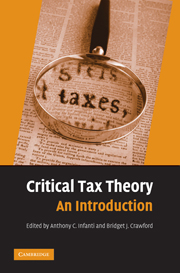Book contents
- Frontmatter
- Contents
- List of Illustrations
- List of Tables
- List of Contributors
- List of Common Abbreviations
- Introduction
- CHAPTER 1 FOUNDATIONS OF CRITICAL TAX THEORY
- CHAPTER 2 HISTORICAL PERSPECTIVES ON TAXATION
- CHAPTER 3 THE GOALS OF TAX POLICY
- CHAPTER 4 CRITICAL TAX THEORY MEETS PRACTICE
- A Legislator Named Sue: Re-Imagining the Income Tax
- Using the Social Background Model to Explain Who Wins Federal Appellate Tax Decisions: Do Less Traditional Judges Favor the Taxpayer?
- Tax Protest, “A Homosexual,” and Frivolity: A Deconstructionist Meditation
- Sisters in Law: Gender and the Interpretation of Tax Statutes
- Deconstructing the Duty to the Tax System: Unfettering Zealous Advocacy on Behalf of Lesbian and Gay Taxpayers
- CHAPTER 5 RACE AND TAXATION
- CHAPTER 6 GENDER AND TAXATION
- CHAPTER 7 SEXUAL ORIENTATION AND TAXATION
- CHAPTER 8 THE FAMILY AND TAXATION
- CHAPTER 9 CLASS AND TAXATION
- CHAPTER 10 DISABILITY AND TAXATION
- CHAPTER 11 GLOBAL CRITICAL PERSPECTIVES ON TAXATION
- CHAPTER 12 CRITICAL PERSPECTIVES ON CRITICAL TAX THEORY
- Index
A Legislator Named Sue: Re-Imagining the Income Tax
Published online by Cambridge University Press: 04 August 2010
- Frontmatter
- Contents
- List of Illustrations
- List of Tables
- List of Contributors
- List of Common Abbreviations
- Introduction
- CHAPTER 1 FOUNDATIONS OF CRITICAL TAX THEORY
- CHAPTER 2 HISTORICAL PERSPECTIVES ON TAXATION
- CHAPTER 3 THE GOALS OF TAX POLICY
- CHAPTER 4 CRITICAL TAX THEORY MEETS PRACTICE
- A Legislator Named Sue: Re-Imagining the Income Tax
- Using the Social Background Model to Explain Who Wins Federal Appellate Tax Decisions: Do Less Traditional Judges Favor the Taxpayer?
- Tax Protest, “A Homosexual,” and Frivolity: A Deconstructionist Meditation
- Sisters in Law: Gender and the Interpretation of Tax Statutes
- Deconstructing the Duty to the Tax System: Unfettering Zealous Advocacy on Behalf of Lesbian and Gay Taxpayers
- CHAPTER 5 RACE AND TAXATION
- CHAPTER 6 GENDER AND TAXATION
- CHAPTER 7 SEXUAL ORIENTATION AND TAXATION
- CHAPTER 8 THE FAMILY AND TAXATION
- CHAPTER 9 CLASS AND TAXATION
- CHAPTER 10 DISABILITY AND TAXATION
- CHAPTER 11 GLOBAL CRITICAL PERSPECTIVES ON TAXATION
- CHAPTER 12 CRITICAL PERSPECTIVES ON CRITICAL TAX THEORY
- Index
Summary
When America's Founding Fathers gathered to establish the legal framework for the new republic, Abigail Adams wrote to her husband John Adams asking him to “remember the ladies.” For countless generations lawmaking had occurred this way; when the vote was called, the answering voices were always male. Women were heard only indirectly through the men. Centuries later, a few of those voices are finally female. Now that a woman can directly influence legislation, the question is whether her voice makes a difference. The answer is yes. Studies indicate that women legislators, regardless of whether they are feminists, act differently from male ones, and this difference affects the legislative process as well as policy outcomes. As a consequence, the presence of female legislators makes a difference not only for women, but for men as well.
That the mere existence of women legislators would make such a difference should not be surprising. The force of gender is both everywhere and nowhere. It is everywhere, affecting how people dress, walk, talk, work, and play; how people structure society; and how they think about themselves and about others. It is also nowhere, however, because much of gendered behavior is invisible. It is hidden behind the guise of universality imposed by male dominance, which is one of the few consistent manifestations of gender throughout recorded history.
Tax laws are no different. The Code, for example, as part of the codified federal laws, incorporates § 1, Title 1 of the United States Code, which states “He includes she.” Although the Code generally avoids this obviously gendered language through its use of the unisex “taxpayer,” there are still many substantively gendered aspects of the tax laws.
- Type
- Chapter
- Information
- Critical Tax TheoryAn Introduction, pp. 75 - 81Publisher: Cambridge University PressPrint publication year: 2009
- 1
- Cited by



